At the end of summer, peppers look better than anything else in my vegetable garden. Corn has been harvested and stalks are drying, tomatoes are getting brown leaves from the bottom up, but peppers remain verdant, and adorned by red, yellow, orange, brown, purple, even magenta fruit — they’re downright ornamental.
One reason that most other plants are worn out by the time that peppers are coming into their own is that peppers are best planted later than those other summer vegetables. In addition to talking about when to sow or plant peppers, I’ll get into a few details about varieties, pests, shading, and supporting peppers, specifically in Southern California.
But first, let’s talk about sowing or planting.
Sowing and planting peppers
Last year, 2019, I sowed pepper seeds in trays in my garage on February 13. I planted them in the garden on June 2, shown here:

We began eating from these plants in the middle of summer.
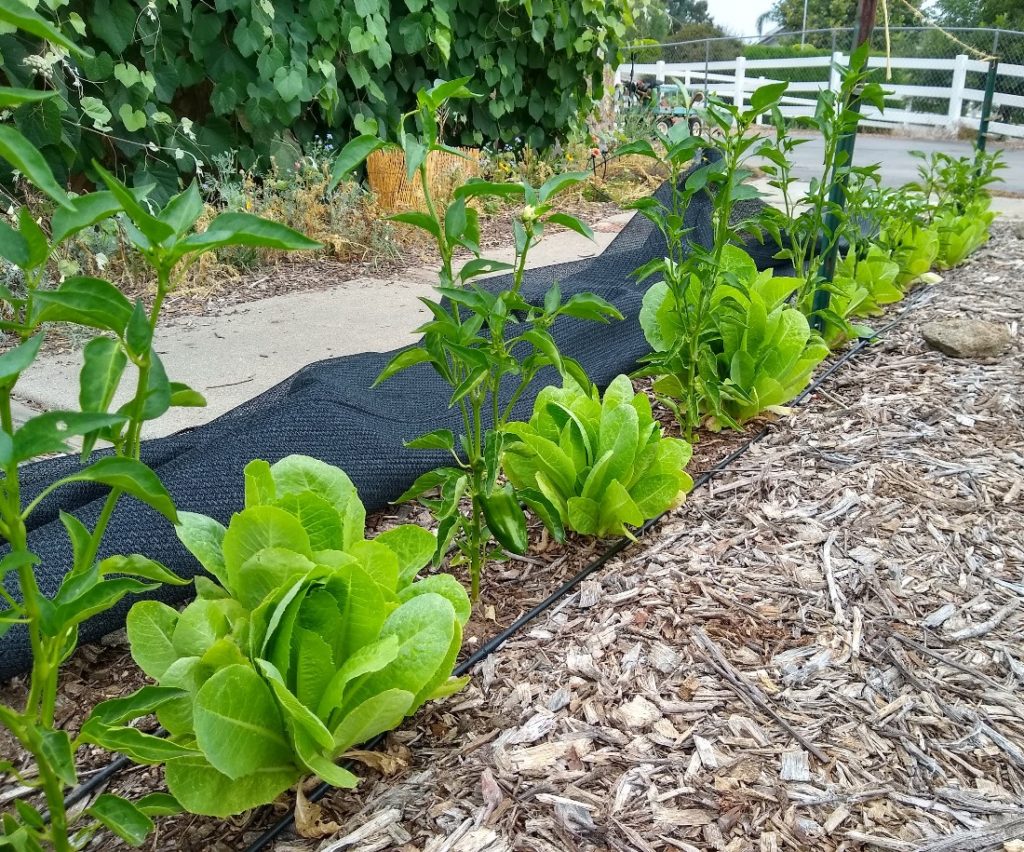
That’s five months of caring for these plants before harvesting from them. Growing peppers from seed is a long process, especially if you don’t use heating mats or grow lights to get them started (I don’t).
So this year, 2020, I chose to grow my peppers from seedlings purchased from Territorial Seed Company in Oregon. The box of seedlings arrived on May 7:
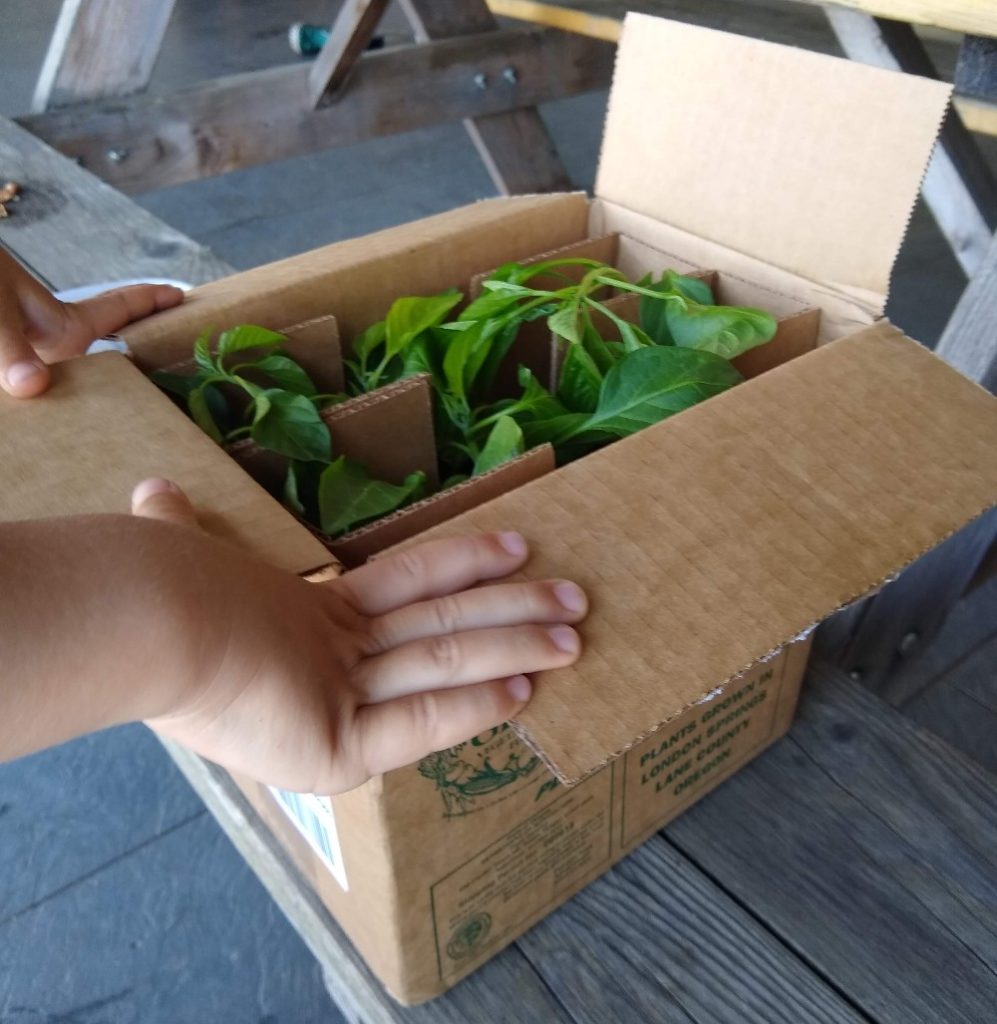
I planted the seedlings on May 9 and we were eating from them starting in mid-summer. That’s only two months of caring for the plants before harvesting from them. It’s usually a wiser use of your time to start your peppers as seedlings rather than seeds. Usually.
If you do start from seed, then February or March are good times to start. And if you start from seedling plants, then May is the ideal pepper planting month.
You can plant peppers earlier than May, but they won’t grow very fast, meaning that if bugs like earwigs start chewing on them then the plants will have a hard time outgrowing the damage. You can plant peppers later than May, but the later you plant the less fruit you’ll get out of the plant for the year.
Why is May a sweet spot for pepper planting? It’s the first month of the year that is warm enough to make peppers happy. This UC Davis publication says that the ideal growing temperatures for peppers are between 75 and 85 degrees, with nights between 50 and 60 degrees. Such temperatures are first reached in most of Southern California in May.
By the way, compared to tomatoes, peppers need it warmer to get started. If you observe when tomato seeds naturally sprout in a compost pile compared to pepper seeds, you’ll notice that the peppers always wait until later, when it is warmer.
Varieties
Which types of peppers should you grow? We grow three main types, and they are chosen based on how we eat our peppers.
From left to right, this year we have Ancho Magnifico (poblano), Padron, Early Jalapeno, Miniature Red Bell, Orange Bell, and Yellow Bell:

First, we must have a poblano type or an Anaheim so we can make “cheater” chile rellenos.

We cut out the stem and seeds, stick a bar of string cheese into the cavity, and put the stuffed peppers into the oven. These cheater chile rellenos we put inside burritos, eat alongside scrambled eggs, etc.
Second, we need peppers of medium heat to add to salsa. That’s where the Padron and Jalapenos come in.
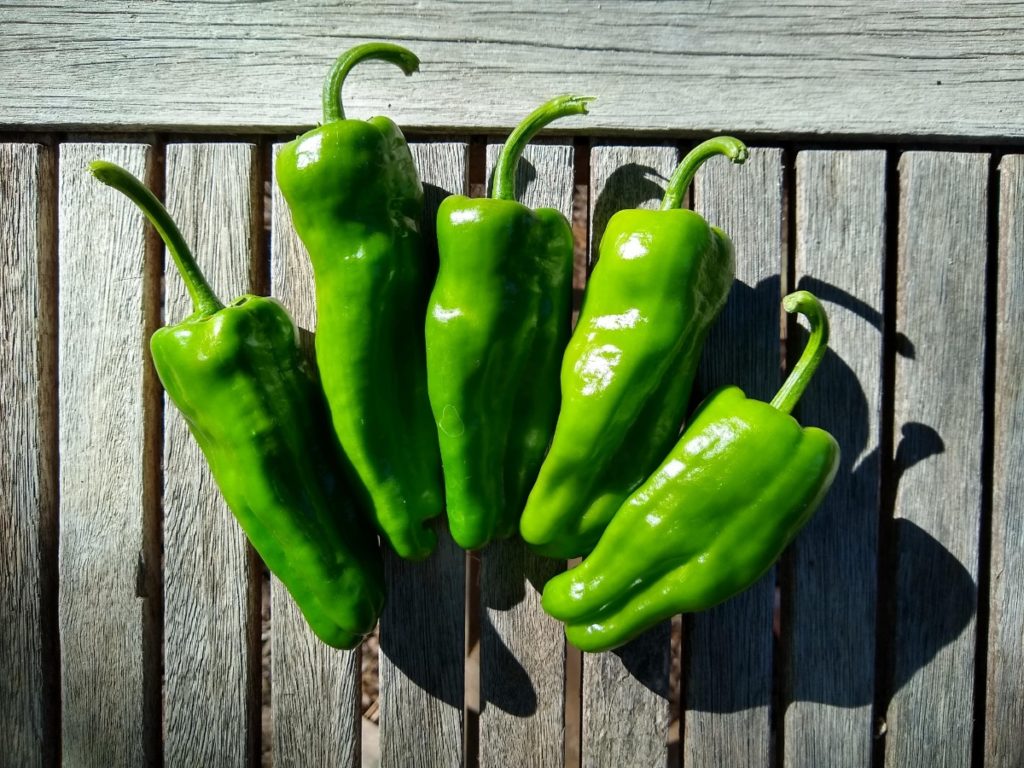
Third, I use sweet peppers as substitutes for iceberg lettuce in sandwiches during the summer. In the past I’ve used banana peppers for this; this year, it’s mini bells. I slice them and put them into a sandwich to get that refreshing crunch.
This year, I’m also using the mini bells as substitutes for carrots. I dip them in hummus for a snack. Anyway, my recommendation is to grow the kinds of peppers that you can make use of. And there are so many kinds of peppers to make so many uses of: hot sauce, pickling, pan blistering . . .
Support
Do you need to support your pepper plants? Sometimes. Often, the smaller-fruited types can stand on their own, holding a crop load without toppling. Here is a Serrano plant that I didn’t need to support a few years ago:
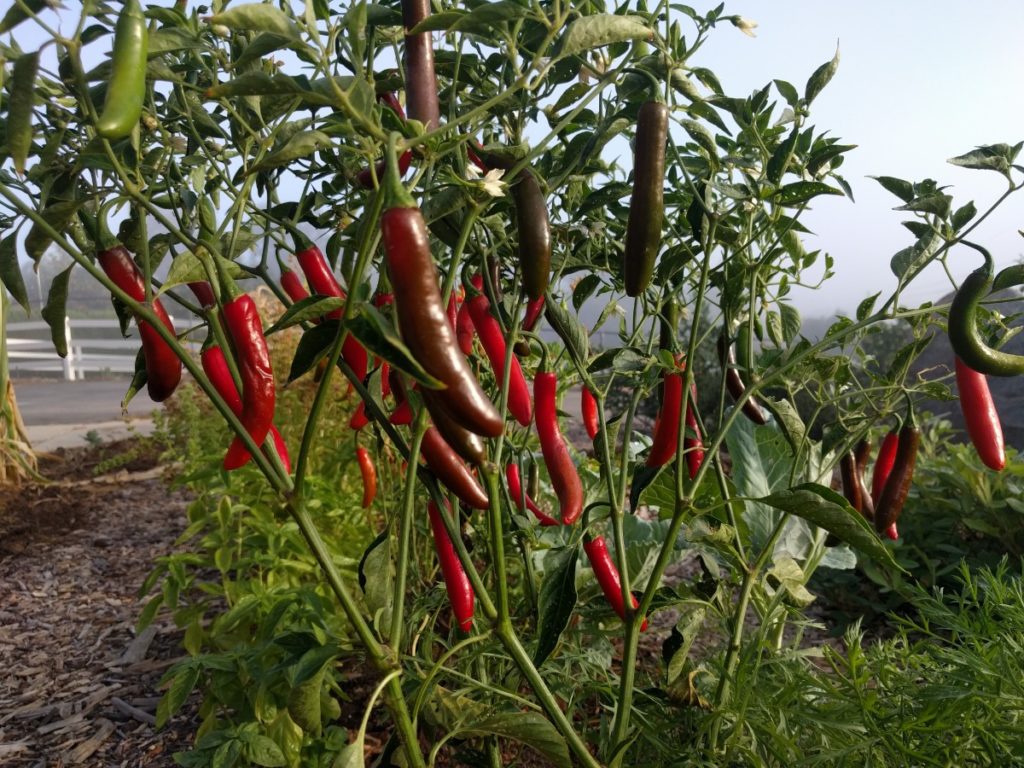
But this year I chose not to wait until plants leaned. I supported them with stakes and string from the beginning, a method similar to what is used with tomatoes. (My post on stringing up tomatoes.)
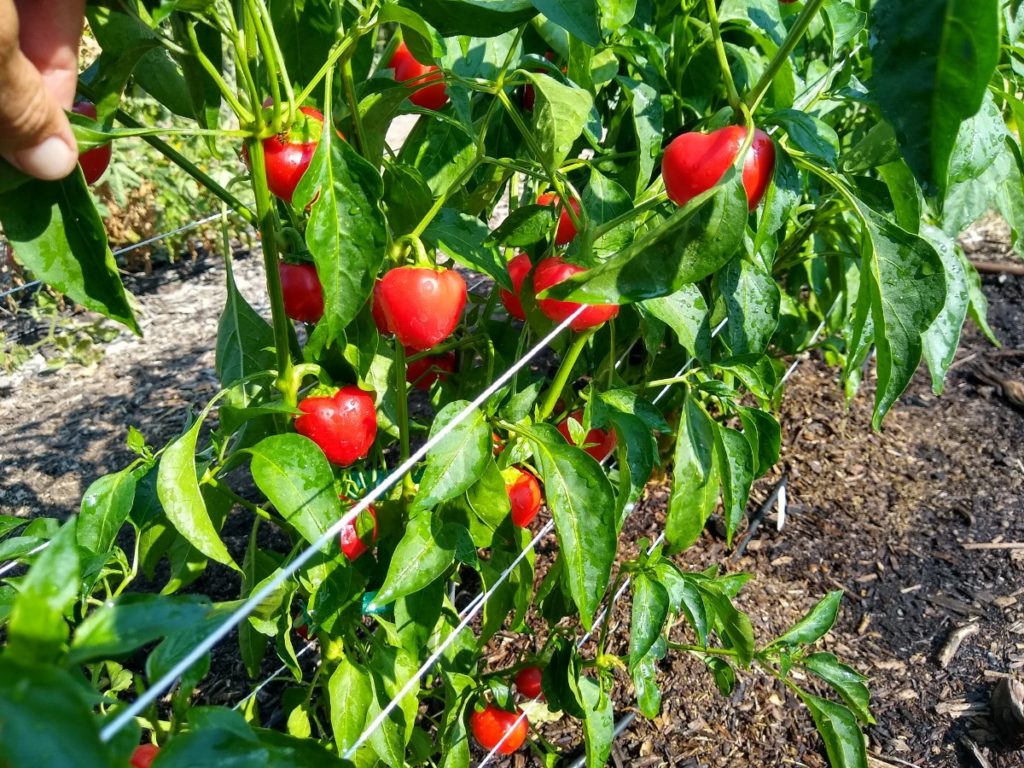
This not only keeps the pepper plants upright, but it also condenses the foliage around the fruit and helps prevent sunburn.
Shading to prevent sunburn
One of the best vegetable gardeners I know once told me, “Anyone can grow green bell peppers.” What he meant was that growing green bell peppers was relatively easy because bell peppers are generally green when they’re young. That is, they only turn yellow, orange, red, or other colors once they’ve spent a lot of time on the plant, a lot of time when they’re vulnerable to pests, diseases, underwatering, and sunburn.
That vegetable gardener, Roy Wilburn, wards off sunburn on his bell peppers in two ways. One, he plants them in double rows, so they’re crowded and shading one another.
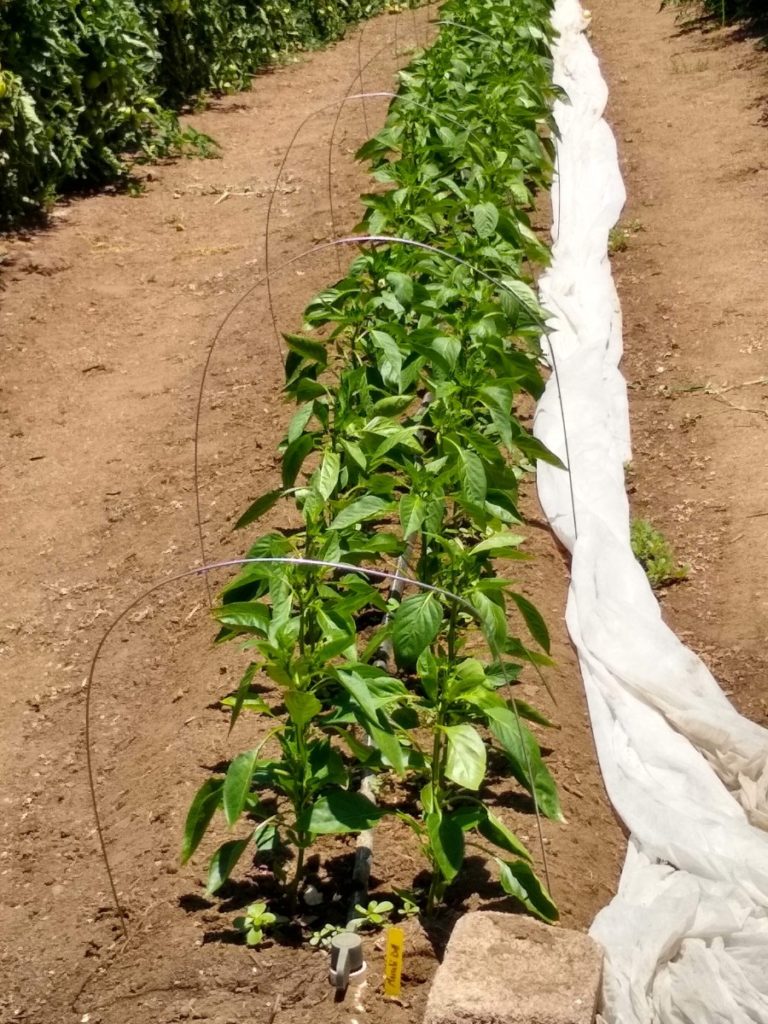
Two, he puts shade cloth over the plants if the temperature reaches over about 90. He uses 30 percent shade cloth draped over metal hoops.
I’ve been covering my peppers with 30 percent shade cloth on hot days, and it has worked. Sunburn is almost zero. A few fruit got a little scalded when it was 109 degrees one day.
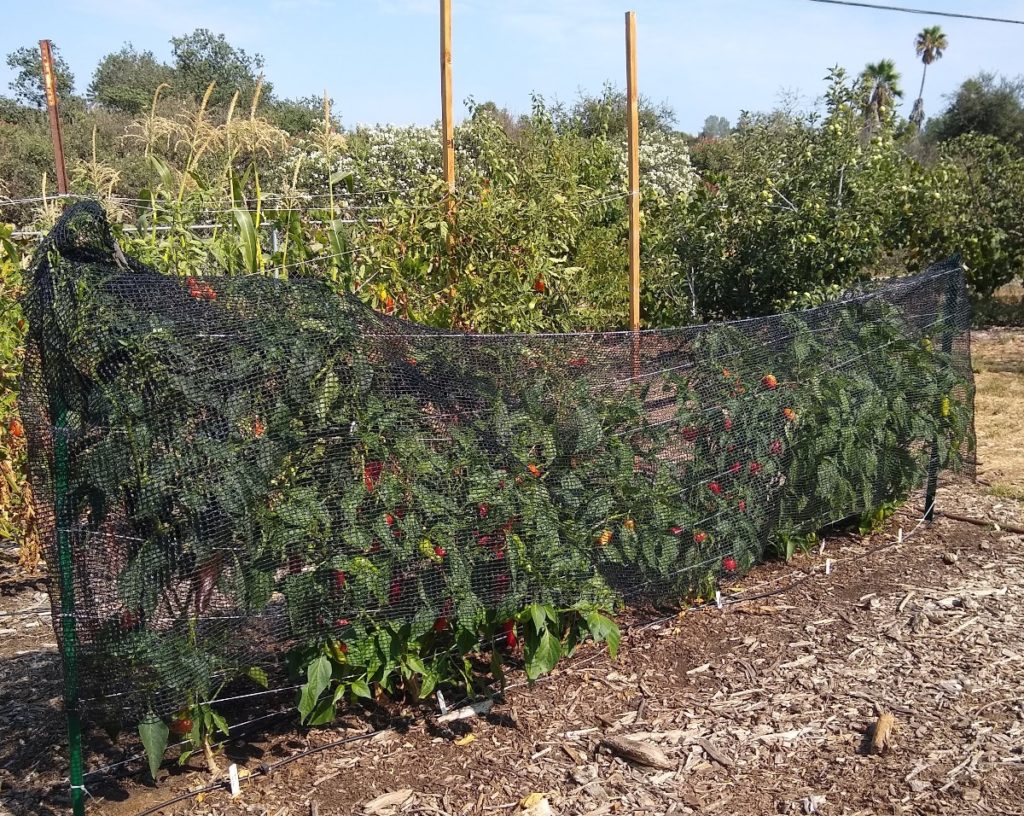
You might wonder whether it would be effective to just plant the peppers in a location with light shade all the time, or shade for half the day. I’ve done that, and the peppers grow and produce and are less susceptible to sunburn, but they produce far less than when they’re in all day sun and only lightly shaded on hot days.
Close to the beach, where days are almost never over 90, sunburn is not a real concern.
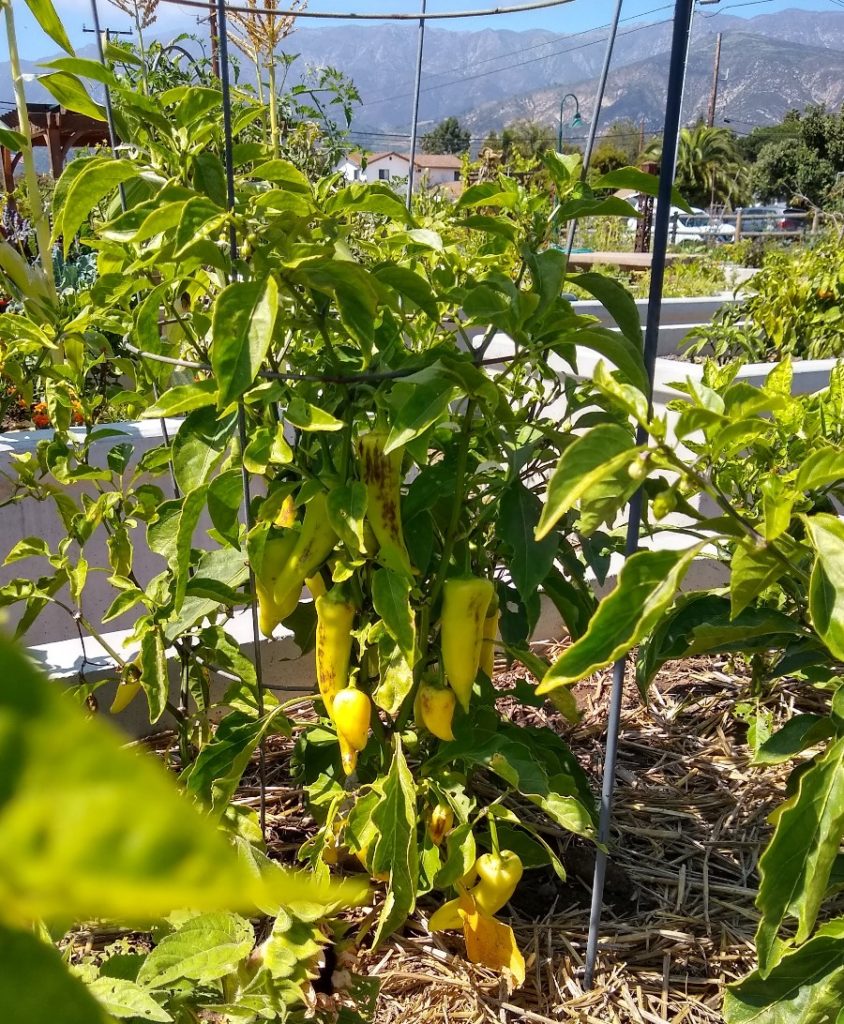
Pests and diseases
I don’t find many pests or diseases to be a concern with peppers either, anywhere I’ve grown them in Southern California.
If you plant late enough, then the earwigs are no longer a problem. I do get aphids on my peppers, but frequent blasting with water keeps them in check.
As on tomatoes, the hornworm will feed on pepper foliage. But you can just pick them off, as my son is about to do here:
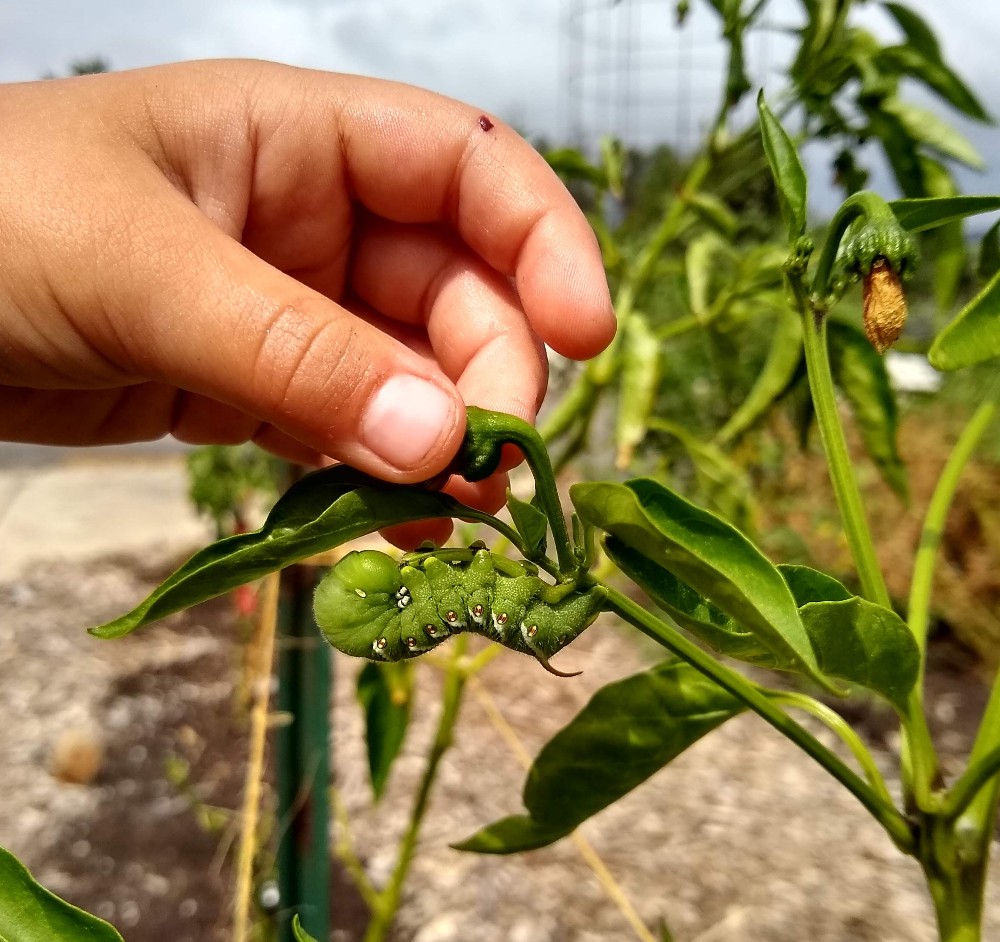
A special pepper plant
Earlier I mentioned that peppers are usually better started from seedlings rather than seeds because of how slowly they grow. Usually. Well, one reason to start some pepper plants from seed is because only through sowing seeds do you gain access to certain varieties.
Back in May of this year, a kind Yard Posts reader from South Africa (living in San Diego) mailed me seeds of the kind of pepper that is grown in that part of the world, sometimes called African Bird’s Eye pepper or Peri-peri. When I lived in Lesotho, these were the peppers that my neighbors helped me grow right by my front door. I added them to my dinners almost every night for years.
On May 17, I sowed the seeds that were mailed to me and got good germination. On July 23, I planted seedlings. Here is one of them today, just beginning to flower:
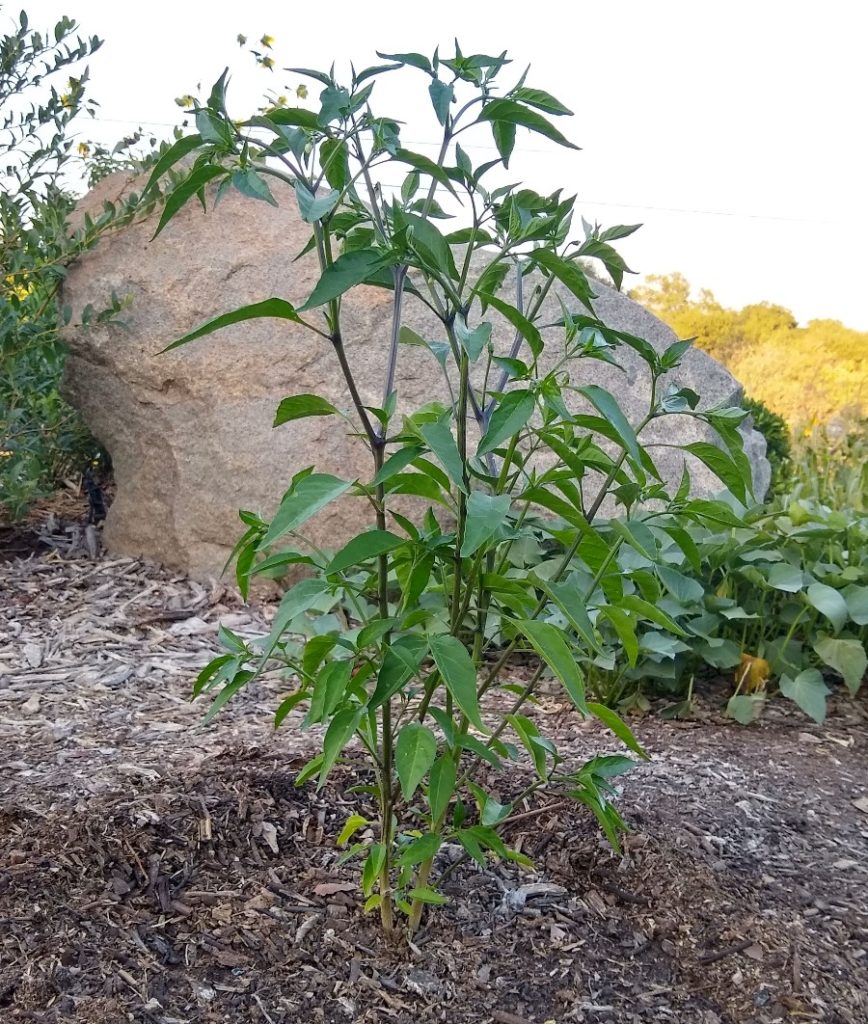
Peppers can be more than plants. They can be memories, connections, and full of hope. (Thank you, Joel!)
All of my Yard Posts can be found HERE

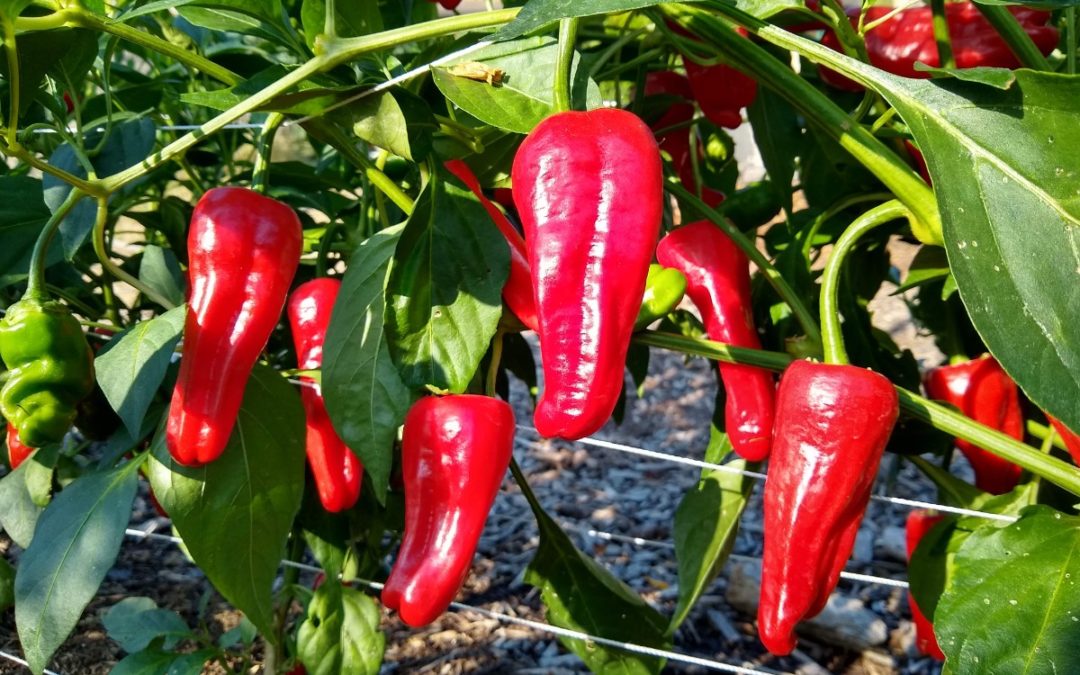


Love that you were able to get the peri-peri going! I get a few RSA plants going out here in the desert. I might give it a try! Peppers do great out here. I have had very little luck with tomatoes, unfortunately.
We grow all of our peppers from seed, because our goal is to get varieties we couldn’t otherwise. This year’s favorite is Haskorea, which is a Syrian type similar to Aleppo pepper – very fruity, about as hot as a jalapeño. Still waiting on a second planting of Arroz Con Pollo (a Cuban pepper that is advertised as a flavor bomb of a habanero minus the heat) – it seems to like the world a few degrees warmer than other peppers, and the early planting didn’t do well. Also, on the tomato variety front, Abu Rawan, which is an open-pollinated determinant Iraqi variety, did spectacularly across our Inland SoCal/Texas/Oklahoma tests. The tomatoes aren’t as spectacular as some of the heirlooms, but they are far superior to any grocery store tomato, and the yields were spectacular (40-60x 2-3 oz fruits from a single compact plant). It will set fruit a good 5 degrees warmer than most other varieties.
Hi Beth,
Thanks so much for these notes. I love Aleppo peppers so I’m very interested in Haskorea. Can you recommend a source of seed? Same for the Abu Rawan tomatoes?
I got both from Baker Creek in Missouri. And of course, for every new variety I try that becomes a standard, there is one that is an utter disappointment.
I agree with you, growing peppers from seeds is indeed a long process, but I like to start them am early as possible. I plant my seeds in December and start harvesting at the beginning of June. I also grow a few European varieties that I cannot find at any nursery, so starting from seeds is my only option.
Hi Chip,
Any European varieties that you would recommend?
My favorites are called gogosari.
I had a miserable time getting peppers to grow here (near SDSU) until this year. I bought seedlings and put them in my green house. Gobs and gobs of peppers. It’s a don cheepo harbor freight green house with the door open all summer. I did keep the door closed early on, though, until things warmed up a bit.
Thank you for another helpful & informative post Greg! No wonder my peppers haven’t been growing well, they aren’t in all day sun. 🙁
What a helpful post (as usual) Greg! I have one pepper plant with peppers that look like serranos but only have a tiny bit of heat, much less than most jalapeños, which makes it wonderful in many dishes. I wish I could identify it (is there a way to send a picture?). What I also like about this nameless variety is that this is its third season (planted in spring 2018) and it still looks so strong that I expect to get a fourth year out of it. Even in full sun in this terrible heat (yesterday it was 109 and today it’s predicted to repeat) this nameless pepper looks bullet proof. I understand that peppers are considered to be tropical perennials but most places in the USA treat them as annuals. I’ve had a couple of other peppers that were strong for 2 or 3 seasons here in the La Mesa hills, but I’ve never gotten jalapeños or bell peppers to do well for more than one season. I wonder what makes some do better than others. Some eggplants also do well for 2 or 3 seasons, though a friend has warned me that by keeping them going for multiple seasons I’m inviting nasty diseases into the soil. What about peppers in SoCal?
Hi Nick,
I love this topic, and I thought about including it in the post. Glad you brought it up. I’ve had pepper plants grow in my yard for two or three years many times too, but I’ve also never had a bell or jalapeno pepper do this well. The kinds of peppers that have lasted many years and produced well the whole time for me have been small, hot types, like Cayenne or smaller. I don’t know why these types have the most stamina.
You could post a link to a photo of your peppers on a platform like Google Drive.
Please keep seeds of that plant. Sounds like a winner.
Hi Greg,
I’m in coastal San Diego, and sowed my pepper seeds indoors in Feb. They failed to thrive, so I started over in late March The weather has not warmed up. Day time temps haven’t gone above 70, and night temps remain in the 50s. At this point they’re less than 2 inches tall and just starting to get their true leaves. Last year, the peppers I’d sowed in late March (Shishito, Nardello, and Poblano) were much more robust. The peppers I have now are Anaheim and Santa Fe Grande. Do you think I just need more patience? Thanks!
Hi Lyn,
Pepper seedlings require more patience than any other seedlings I know. I didn’t even grow any this year. I just bought all of my pepper seedlings this year.
Are you moving them indoors at night (to keep them warmer) and then outdoors in full sun during the day? This is the best you can do without a greenhouse. Otherwise, you’re dependent on the weather, and you just have to wait on it. Being near the beach, you probably won’t really warm up until the Fourth of July!
The good news is that peppers continue to produce well through fall and into winter — sometimes throughout winter. I’ve started to rely on my overwintering pepper plants for fruit in the spring and early summer. (I’m eating such fruit now.) Then I expect to eat from new pepper plants only starting in mid to late summer, but they continue to produce very well to the end of the year.
Haven’t been moving them indoors. I was hoping the weather would warm up, so I wouldn’t have to. But the weather seems to have other plans. 😉 Guess I’ll hang on the little seedlings for a bit more. Good to know I can start later if I have to. Thanks for the help and encouragement!
Hi Greg, I started a wide variety of tomatoes and peppers this year from seed. I transplanted them at the beginning of May and every single one has disease. The leaves are turning black and wilting off. Any suggestions on what this could be?
Thanks,
Steve
Hi Steve,
What did you use as a seed-starting medium?
I used garden soil/compost, my worm castings and peat moss.
Hi Greg,
I’ve been told peppers will get hotter over the years if you can keep them alive over winter. How true is this. I have a poblano/ancho I was able to save from last year. It is loaded with young peppers; the plant itself there is not much to it, half the size of last year.
Thanks,
joe from Bakersfield
Hi Joe,
I don’t know. I have kept many pepper plants for two or more years but have never noticed an increase in heat. So I’d say that if there is an increase, it must be small.
Have a Cubanelle that has wintered over in SoCal and that will be easy to protect if we have a late frost. It is COVERED with baby peppers, some the size of dimes and quarters but most much smaller. Should I pick off some of them to encourage growth in the others?